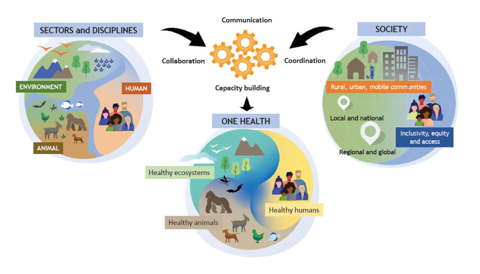
Marmar Nekoro
Assessor and Researcher,
Department of medicinal products in veterinary use,
Swedish Medical Products Agency

The One Health approach emphasises how human, animal and environmental health are interlinked and must be prioritised to prevent future global health crises.
The following article is the first of a series on different elements of the One Health approach and the impact of medicines, written by Marmar Nekoro and James Mount from the Department of medicinal products in veterinary use at the Swedish Medical Products Agency. This article introduces the overall concept and key principles of the One Health concept. Subsequent articles will discuss how One Health is interconnected with antimicrobial resistance (AMR), ecopharmacovigilance (EcoPV) and zoonosis.
There is a scientific consensus that the health of humans, animals, and ecosystems are all interconnected, exemplified by such global issues as the growing frequency and impact of global health crises, antimicrobial resistance (AMR), and climate change. The term “One Health”, which was widely adopted during the 2023 World Health summit in Berlin, is an approach that emphasises this interdependence. One Health promotes interdisciplinary efforts to develop optimal approaches to maintain animal, public, and environmental health.
1. Interconnectedness: Humans, animals (wild and domestic), and ecosystems (including plants, fungi, and bacteria) are deeply interconnected, and One Health is an integrated, unifying approach aiming to sustainably balance and optimise the health of all these domains.
2. Intersectoral and interdisciplinary collaboration: Addressing health challenges requires collaboration among various sectors and disciplines including medicine, veterinary science, public health, environmental and social science. This can be enabled through intersectoral coordinating committees or taskforces at national and international level.
3. Prevention: One Health emphasises a proactive approach to promote health and prevent diseases. This can be achieved through ensuring food and water safety including access to clean water and reliable sanitation. Strengthening biosecurity, monitoring and controlling zoonoses and managing antimicrobial resistance are other key aspects.
4. Global perspective: Pandemics, climate change, and biodiversity loss are examples of health issues and global challenges that require jointly identifying solutions and coordinated international responses across multiple sectors, disciplines, and communities at varying levels of society. This can be facilitated through sharing information via shared databases and surveillance platforms.
The concept is not new; an integrated approach to health issues was proposed long before the name “One Health” was introduced. However, over the past three decades a large amount of evidence has emerged showing how problems in one of these areas affects the others. For example, statistics from World Organisation for Animal Health (WOAH) indicate that more than 75 % of emerging infectious diseases among humans are of zoonotic origin. Zoonotic pathogens may be bacterial, viral, or parasitic, and can be transmitted between humans and animals through direct contact with animals, or via food, water, or the environment.
To be effective, the One Health approach requires cooperation and collaboration between relevant sectors and disciplines, such as agriculture, human medicine, veterinary medicine, epidemiology, environmental and social sciences, and governance. These sectors need to work together at national, regional, and international levels to prevent, identify, and monitor existing and emerging issues and mitigate them. This is somewhat supported by the creation of the global “Quadripartite” in 2022.
The Quadripartite is a collaboration between four principal agencies: the Food and Agriculture Organization of the United Nations (FAO), the United Nations Environment Programme (UNEP), the World Health Organization (WHO), and WOAH. Each agency brings its own expertise to this much needed partnership. For example, the WOAH provides expertise in animal health and welfare.
The Quadripartite plays a central role in promoting and coordinating a global One Health approach by highlighting the need for enhanced collaboration and commitment to implement approaches into policy action throughout the world. Together, the Quadripartite aim to develop global strategies to tackle major diseases or broader health threats, including AMR. Specific global strategies and their implementation will be discussed in subsequent articles.

Within Europe, the European Commission has recognised the importance of One Health through the publication of a dedicated governance in the European Union based on advice from the Scientific Advice Mechanism. This governance highlights the need for better coherence of EU policies and provides support to research, innovation, and education on One Health. For example, regarding the impact of pharmaceuticals, the European Medicines Agency contributes to One Health via a joint framework with four other EU agencies. EMA's One Health approach involves enhanced EU action against AMR and the presence of pharmaceuticals in the environment which is in line with the current Veterinary Medicinal Products Regulation and the ongoing reform of the EU pharmaceutical legislation.
Global implementation of the One Health approach can improve human, animal, and environmental health and reduce the risk of outbreaks in the human-animal-environment interface. In turn, this can help the achievement of internationally agreed goals such as the United Nation’s 17 Sustainable Development Goals and the EU One Health Action Plan against AMR. Stay tuned to learn more about AMR through the One Health approach lens.
Despite focusing on different species, human and veterinary pharmacovigilance share many goals and approaches, offering opportunities for mutual enhancement of the two disciplines.
06 November 2025
From software updates to complex human-machine interactions, medical devices pose safety challenges that require dedicated frameworks beyond drug vigilance.
28 August 2025
Counterfeit drugs threaten millions worldwide, yet healthcare workers often lack training to spot fakes or report them, leaving this problem largely invisible.
01 October 2025